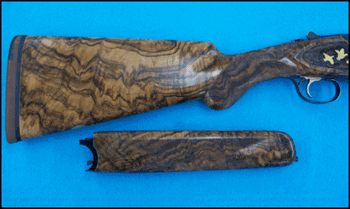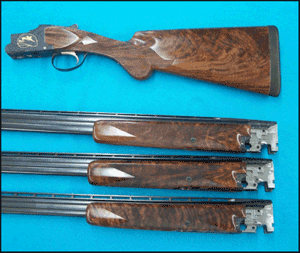Robert James and The Point of Impact
Robert James pulls no punches: “I’m really upset with the shooting industry, including myself,” he says.
What could possibly rile the likes of Mr. James, a 75-year-old master stock maker?
After all, he’s at the pinnacle of his career — making sumptuous stocks for the world’s best shotgun manufacturers. Plus, in his pursuit to make the perfect shotgun stock, “the last 20 years of my study have been the most exciting and revealing.”
He has two books about shooting ready for publication in the fall. And the Montana GunFitting Academy that he started in 2005 with his wife is attracting some of the industry’s top talent.
The Shooter’s Frustration
So what the heck is bugging Robert James?
“The retention rate in the shotgun industry is pathetic,” he says. “We lose 80% of the shooters in two years, and I maintain its frustration.”
He should know first-hand. As the owner of stock-maker Montana LongGuns, Inc., he’s on the leading edge of the frustration curve — especially when it comes to new shooters. Because if a shotgun doesn’t fit well, the shooter won’t shoot well. And if the shooter doesn’t shoot well, they go ahead and trade in their shotgun for a set of golf clubs.
He observes…
“As a new shooter you come onto the range and you want to teach yourself how to shoot. But you end up getting advice from John and Bill and Sam and a lot of it is conflicting and none of it is scientifically proven.”
Yes, that’s the rub. The shotgun industry has abandoned new shooters to the vagaries of fraud, folklore and fibs. The new shooter eventually finds himself overwhelmed by all the contradictory advice and gives up — lock, stock and barrel.
The Quest
So to keep shooters in the game, and to perfect his stock-making, Mr. James embarked on a quest some 20 years ago. He calls it the Point of Impact. And it’s the Point of Impact that makes the difference between a great-fitting shotgun stock and a pretty-good fitting shotgun stock.
The Point of Impact is almost a theology. Because it makes the assumption that the shooter is “perfect,” meaning that all the physical and mental attributes to break targets are God-given — and that a man or a woman is capable of breaking any target within range.
“I am absolutely convinced that we humans are more marvelous than we give ourselves credit for,” he said. “We can achieve this (perfect score) if we have correct information and have the discipline. We can carry that on in the shooting arena. If the new shooter has correct information he will get great results.”
A factor in having the correct information is an accurate picture of the shot — and it mostly starts with a perfect shotgun stock.
With that assumption as a given, it then becomes incumbent on the likes of Mr. James to bring out that human perfection in the form of consistent shooting. And that begins with a mission, a higher calling if you will, which he calls The Point of Impact.

The Legacy of His Father’s Shotgun
For Mr. James, this pursuit started over 55 years ago. As an adolescent growing up in Missouri, he was a good shot with his .22 rifle. But when it came time to shoot his father’s 12 gauge shotgun, he missed just about everything.
One of the first things he realized was that he looked down the barrel of that old 12 gauge — sighting it as he did his rifle. What he wanted to achieve was the same consistency and repeatability with the shotgun that he enjoyed with this rifle.
The first breakthrough came with the introduction of sporting clays in America. As he recalls, “When I started I only had to work with premounted shotguns like trap and skeet. When sporting clays started about 30 years ago, I had to shoot low gun. I had to shoot every imaginable target thrown by man.”
When you consider that enormous challenge, the shooter is faced with a whole new set of hurdles that Mr. James took on as his own. He delved into “understanding the human anatomy, optometry, the central nervous system, the conscious and subconscious minds. I began to realize that there must be a way to handle the gun, to get it up to my face properly and consistently each and every time.”
The Perfect Way
It goes beyond a custom-fitted stock made from a try gun — a point driven home by his tenure as a stock maker at Purdy in 1974-75.
“I thought Purdy was the best,” he explained. “I had a friend in the U.S. who was there and he made arrangements for me to work there for a year. They were going to teach me everything they knew about stock fitting. I came away disgruntled because they were doing the same thing that we do in the U.S. Just the fact that they weren’t so much concerned about all the elements, that they wouldn’t take into account muzzle flip, felt recoil, perceived recoil, the things that affect both the shooter’s mind and ability to be consistent.”
He now recalls “The question for me then became: Is there a perfect way for me to handle this gun that’s scientifically proven? Yes there is.”
The Point of Impact
The past three decades pursing The Point of Impact have given him a mountain of information that he’s ready to take to the next step: scientific proof. That’s where the shotgun industry leaves shooters, especially new shooters, stranded to the vagaries of on-the-fly instructions.
“Somewhere, some time, some place, we need volumes of information that are scientifically proven. I’m very cautious about the information I can put out and it must be proven scientifically without a shadow of a doubt.”
That would take him to the next phase of the undertaking that he calls The Point of Impact — the ability to compile all that data into a statistically proven model with the necessary backup to make his argument irrefutable.
What’s holding him up at this point? Well, he does have a successful business to run.
“We build custom stocks for several manufactures like Browning, Krieghoff and Kolar,” he said. Those companies measure the client then send the specifications to Montana LongGuns.

A Private Consultation
If you were to visit Mr. James for a private consultation for a stock fitting, he’ll spend about an hour with you talking about your concentration, how you expect the shotgun to handle, any problems you’re currently having, your eyesight — all the facets of shooting. — before he even picks up a try gun to take your measurements.
“What you want is to get the same results over and over,” he said.
To make his point, he talks about a stock customer who hit 1,437 consecutive skeet targets with a 28-gauge. “So I asked him, what happened to 1,438?”
And in a way, that’s where his scientific pursuit comes in. If a stock is perfect, nothing should change with the shooter. Each time the shooter mounts the gun, the same sight picture appears, it sits in the same pocket in the shoulder and the face falls in the same place on the stock.
“You should be able to handle this stock 1,000 times in a row and nothing changes,” he said.
Or you should be able to handle it 1,438 times in a row and not miss a single target. — at a minimum.
Irwin Greenstein is Publisher of ShotgunLife.com.
Helpful links:
http://www.mtlongguns.com/index.htm

Irwin Greenstein is Publisher of Shotgun Life. Please send your comments to letters@shotgunlife.com.


Comments